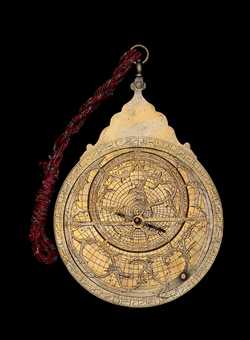Astrolabes /
Browse / 38862
| Date | 1653/4 (A.H. 1064) |
| Maker | Ḍiyā’ ad-Dīn Muḥammad |
| Place | Lahore |
| Material | Brass |
| Inventory no. | 38862 |
| Acquisition | Presented by J. A. Billmeir in 1957 |
View all
images for this astrolabe
View
detailed provenance for this astrolabe
Mater
The mater and limb are of one-piece construction. The tab that prevents the plates from rotating is located at the bottom of the instrument. Scales on the limb: degree scale. More informationBack
The back contains 11 scales of the following types: Altitude; Declination; Sine/Cosine; Cotangent; Shadow square; Zodiacal signs; Lunar Mansions. The back is inscribed: with a maker's signature marked as عمل اقم العباد ضيا و الدين ابن قايم محمد اسطرلابى ١٠٦٤ سنه (The work of the least of the servants, the astrolabist Ḍiya ad-Dīn ’ibn Muḥammad, year 1064). More informationRete, Pin & Horse
The rete contains 37 stars. The zodiac on the rete is labelled: الحمل , الثور , الجوزا , الشرطان , الاسد , السنبله , الميزان , العقرب , القوس , الجدى , الدلو , الحوت.The rete contains 1 scale of the following type: Ecliptic.
The rete is attached using a pin & horse. The pin is held in place by a rather ornate and life-like horse. More information
Rules & Alidades
| Type | Details |
|---|---|
| Alidade | Double-ended. The rule is not original. The alidade
is almost certainly a replacement; the metal and the
finish are distinctly different from the rest of the
instrument. |



